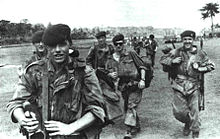
A paratrooper is a military parachutist—someone trained to parachute into an operation, and usually functioning as part of an airborne force. Military parachutists (troops) and parachutes were first used on a large scale during World War II for troop distribution and transportation. Paratroopers are often used in surprise attacks, to seize strategic objectives such as airfields or bridges.
Operation Cooney was the deployment of elements of the 4ème Bataillon d'Infanterie de l'Air - the 4th Free French Parachute Battalion - also known as 4th Special Air Service.

The 2nd Foreign Parachute Regiment is the only airborne regiment of the French Foreign Legion. Since the regiment's arrival from Algeria in 1967, it has been stationed at Camp Raffalli near the town of Calvi on the island of Corsica, south of mainland France. It is one of the four infantry regiments of the 11th Parachute Brigade and part of the spearhead of the French rapid reaction force. The regiment is also equipped with Véhicule de l'Avant Blindé (VAB).

The 1st Marine Infantry Parachute Regiment is one of three regiments in the French Army Special Forces Command.

The 3rd Marine Infantry Parachute Regiment is an airborne elite regiment of the French Army heir to the 3rd Colonial Commando Parachute Battalion 3e BCCP created in 1948 and the 3rd Colonial Parachute Regiment 3e RPC. The regiment is part of the 11th Parachute Brigade.

The 6th Marine Infantry Parachute Regiment is an airborne unit of the French Army.
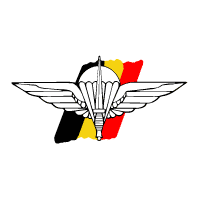
The Special Operations Regiment, formerly the Light Brigade, is a Regiment of the Land Component of the Belgian Armed Forces. Its headquarters is located in Marche-en-Famenne. Known until 3 July 2018 as the Light Brigade the regiment is Belgium's special operations and rapid response unit.
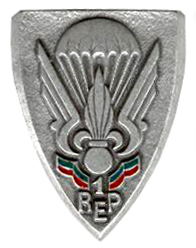
The 1st Foreign Parachute Regiment was an airborne regiment of the French Foreign Legion which dated its origins to 1948. The regiment fought in the First Indochina War as the three-time reconstituted 1st Foreign Parachute Battalion, the Suez Crisis and Algerian War, but was dissolved along with the 10th Parachute Division and 25th Parachute Division following the generals' putsch against part of the French government in 1961.

The 3rd Battalion, Parachute Regiment, is a battalion sized formation of the British Army's Parachute Regiment and is a subordinate unit within 16 Air Assault Brigade.

The 5th Special Air Service was an elite airborne unit during World War II. It consisted entirely of Belgian volunteers. It saw action as part of the SAS Brigade in Normandy, Northern France, Belgium, the Netherlands and (Germany). Initially trained in sabotage and intelligence gathering, they converted to motorized reconnaissance on armored jeeps. They were the first Allied unit to set foot onto Belgian soil and the first to cross the Siegfried line, albeit accidentally.
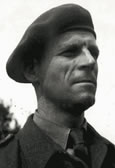
Lieutenant-Colonel Dr. (Dent.) Edouard "Eddy" Blondeel DSO was the wartime commander of the Belgian 5th SAS. After the war he was first C.O. of the 1st Regiment of Parachutists. He retired from the army in 1947 to work as an engineer with Wiggins Teape.

The Special Operations Regiment is an elite fighting force in the Belgian Land Component, consisting of two paracommando battalion’s, the Special Forces Group and a support unit of the Communication & Informationsystems Group (CIS). Known until 2003 as the Para-Commando Brigade, and later as the Light Brigade. On 3 July 2018, the Light Brigade transformed into the Special Operations Regiment.
The 2nd Commando Battalion is a military formation of the Belgian Armed Forces and part of the 'Special Operations Regiment'. Its regimental traditions, including the name "Commando" and the green beret, were adopted from the Belgian soldiers who served in No. 10 (Inter-Allied) Commando during the Second World War.

The 3rd Parachute Battalion is a military formation of the Belgian Armed Forces and part of the Special Operations Regiment. It carries on the regimental traditions of the Belgian Korean War volunteers.
The 4th Commando Battalion was a Belgian military formation and part of the Paracommando Regiment, based in the Belgian colonies of Congo and Rwanda-Urundi between 1959 until its disbandment in 1962, following the independence of Belgium's last African colony. In the 1970s, the unit was revived as 4th (Reserve) Commando Battalion before it was finally disbanded in 1979.

The Para-commando Anti-Tank Company, usually shortened to ATk Company was a formation of the Belgian Army and part of the Para-commando Regiment. In 1994, it was merged with the 3rd Lancers Squadron to form the 3rd Parachute Lancers Regiment.

The 1st Foreign Parachute Battalion was a foreign parachute battalion of the French Foreign Legion formed from the Parachute Company of the 3rd Foreign Infantry Regiment.
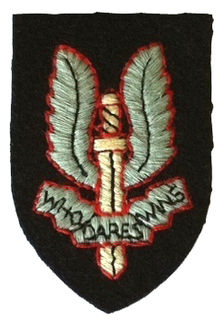
The 2nd Parachute Chasseur Regiment or 2e RCP, is one of the most decorated French units of the Second World War, the only land unit awarded the red fourragère in that war, including six citations at the orders of the armed forces. The French Navy 1500-ton class submarine Casabianca also accumulated six citations at the orders of the armed forces and therefore its crewmen were entitled to wear the same fourragère.
